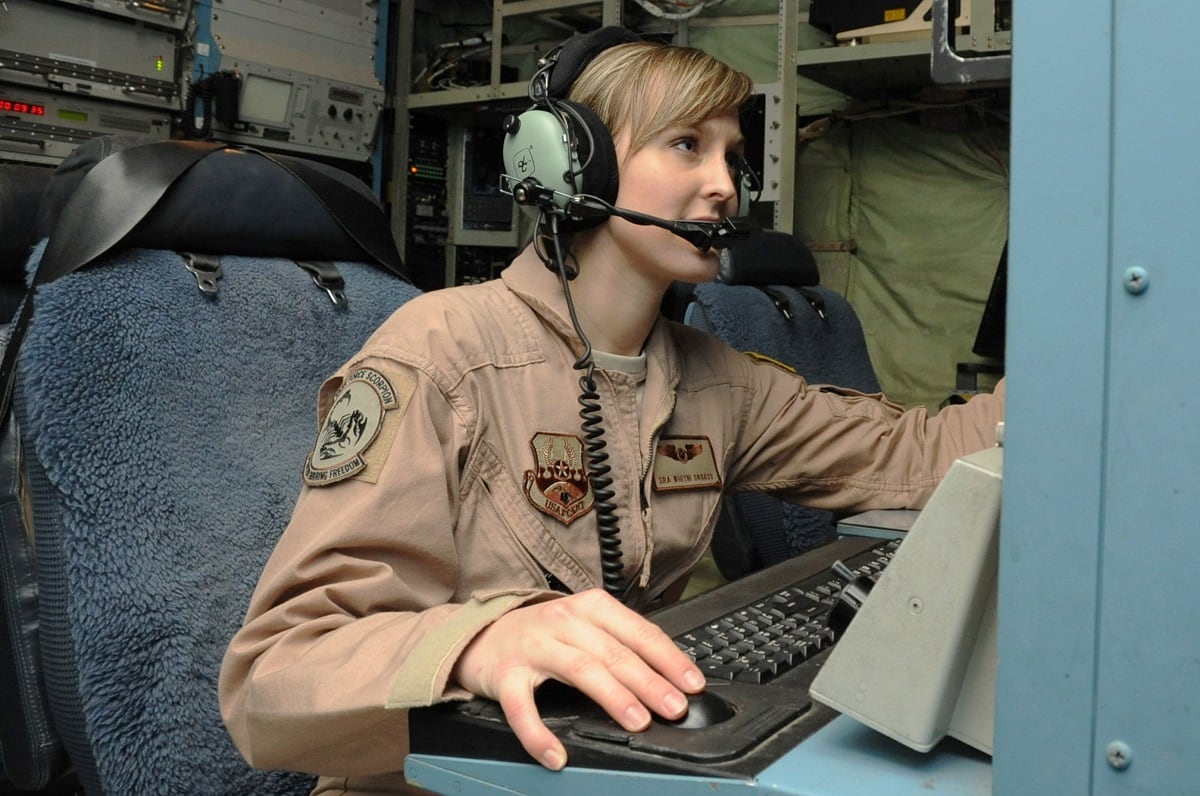WASHINGTON — U.S. Air Force electromagnetic spectrum operations were so meager over the last few decades that the service’s top official said recently that it had been “asleep at the wheel” on electronic warfare.
Among the steps to turn around 30 years of decline and to modernize platforms that date to the Vietnam War, the Air Force reorganized how it manages such operations and is prioritizing easier-to-update technology to keep ahead of China, Russia and other highly adept nations.
At the same time, details about the Air Force plan are limited because the service has not publicly shared the electromagnetic spectrum superiority strategy it completed this spring. Lawmakers have called on the service to increase its efforts.
The Army, by contrast, has broadly discussed its plans in recent years to address how far it fell behind competitors, openly outlining a near complete overhaul of spectrum operations — from new systems to new personnel and units. But the Air Force does not provide top-line numbers for its spending on electromagnetic spectrum efforts.
The new strategy comes as nations have noted the opportunity to disrupt U.S. forces through the spectrum, adopting high-tech methods to block access and jam or spoof communications. They use advanced radars to detect U.S. assets from great distances to prevent sneak attacks, and the American military’s chances for success diminish when it can’t communicate reliably with friendly forces over electromagnetic waves or locate targets because munitions or other systems are jammed.
Now, software-defined systems, which drive electronic maneuvers that could save money over munitions, are a large part of the Air Force’s answer to these challenges.
As Chief of Staff Gen. Charles “C.Q.” Brown put it earlier this year: “In some aspects, an electron is much cheaper than a very expensive missile.” By adopting new capabilities with simple software upgrades, the Air Force could stay abreast with the latest technology to ferret out enemies through their spectrum activities and better shield communications, navigation and data transfers across the waves.

Col. William Young, spectrum warfare special adviser at the Air Force, cited software-defined radios as one adaptable technology example, calling them “the equivalent of a Swiss Army knife.”
“You can think of all the different activities that you can conduct in and through the electromagnetic spectrum — communications, sensing, jamming … you can make it do different things or the equivalent of a different blade just by changing the software,” he said in April at the C4ISRNET Conference.
Getting organized
Despite the lack of specifics on the Air Force spectrum plan, the service’s actions over the past few years and senior leaders’ comments help build a picture of a new course. The Air Force adopted three non-materiel conclusions from its 2018 spectrum superiority study:
- Establish an EMS superiority directorate in Air Force headquarters for more unified oversight.
- Consolidate EMS services and software programming into one organization to improve results.
- Create servicewide education programs to develop an EMS “warrior ethos” and incorporate EMS into more exercises to raise the concept’s profile.
Service officials have said getting the right leadership and organizational structures in place was the needed foundation to build on.
“What we looked at is that there were no shortage of previous studies that had identified materiel gaps,” Young said. “What we found was lacking [were] those other three things; we weren’t able to build sustainable momentum. We might buy something, but then if you don’t fix all the other structures around it, then you’re unable to continue to progress that initial investment or that capability that you bought so that it actually is able to reap the large return on investment that the technology initially promised.”
The new spectrum superiority directorate, located within the A5 strategy section of the staff, takes a day-to-day look at electronic warfare and electromagnetic strategy. And the Air Force elevated its Spectrum Management Office to headquarters level within the A2/6 intelligence and cyber section. The office defends and ensures access to the spectrum for the Air Force and other combatant commands.
The organizational changes already “paid some huge dividends,” Col. Kenneth Miller, the Spectrum Management Office commander, told C4ISRNET. Adding the office to the Air Staff “puts us on par with our service peers in the Army and Navy-Marine Corps,” he said, noting that his office is located with his counterparts in those services to help connect their efforts.
The office has graduated from simply assigning systems spectrum frequencies to supporting forces on spectrum activities that help with electronic warfare. While the office is not directly tied to materiel needs and purchasing, adding it to the Air Staff helps leaders share spectrum expertise with the acquisition community.
Beyond the headquarters shifts, the Air Force in 2019 created its first information warfare unit, 16th Air Force, the operational focal point for electronic warfare, and a Spectrum Warfare Wing will activate around June.
Increasingly, many people within and outside the DoD view electromagnetic spectrum capabilities as one piece of the larger information environment.
“One of the things we’re trying to emphasize more and more is in addition to any of the challenges that we have noted directly with things like EMSO [electromagnetic spectrum operations] is the overlapping and interrelationship with the broader information environment,” said Joseph Kirschbaum, director in the Government Accountability Office’s Defense Capabilities and Management team.
The creation of 16th Air Force to integrate various capabilities was encouraging, he said. “That’s a very good sign that they’re starting to think about these things holistically.”
Investing in new systems
Organizational moves alone aren’t enough, the service’s chief of staff has noted. As the Air Force modernizes older systems, Brown has lauded software-defined capabilities to adapt to rapidly changing threats and possibly save money.
“We’ve got to think about the cost curve” when weighing kinetic and nonkinetic maneuvers, Brown said earlier this year.
Brig. Gen. Mike Manion, director of Air Force EMS, said the service can’t retrofit all its systems but has a “significant effort underway” to update many platforms. “Especially if it’s going to be a software-defined fight as we think it is, then we need the infrastructure and the human capital in place that can rapidly reprogram to counter those threats.”

One example is the EC-130H Compass Call, the Air Force’s only dedicated electronic attack aircraft. The service is modernizing the system to a version called EC-37, transitioning the platform from a C-130 to a Gulfstream 550.
“It’s going to be software defined, hardware dynamic, and it’s capabilities are going to leverage off the rapid reprogramming of the spectrum warfare win,” Manion said.
The Air Force needs revolutionary tactics to create “multiple dilemmas for the enemy using multiple planes and multiple apertures to coherently disrupt and defeat the enemy,” he said.
Some outside experts warned the Air Force is not moving fast enough.
“The Air Force is evolving its EW [electronic warfare] and EMSO capabilities to a more distributed set of platforms and systems, but not very quickly. While the Marine Corps and to a lesser degree the Army are fielding more numerous EW systems and pushing them down to lower echelons, the Air Force still will mostly have its EW systems hosted on large, manned multimission platforms,” said Bryan Clark, director of the Center for Defense Concepts and Technology at the Hudson Institute. The approach increases pilots’ risk of detection, he said.
Lawmakers acknowledged progress but pushed the Air Force to do more.
“I appreciate the Chief’s commitment to restoring our EW pre-eminence,” Rep. Don Bacon, R-Nebraska, a former Air Force electronic warfare official, told C4SIRNET in a statement.
“Control of the electromagnetic spectrum underpins every aspect of our military power in air, land, sea, space and cyberspace so this isn’t a competition we can afford to lose,” he said. “We’ve recently seen some encouraging signs of life from the Pentagon, but I don’t believe we are aggressive enough.”
Mark Pomerleau is a reporter for C4ISRNET, covering information warfare and cyberspace.








